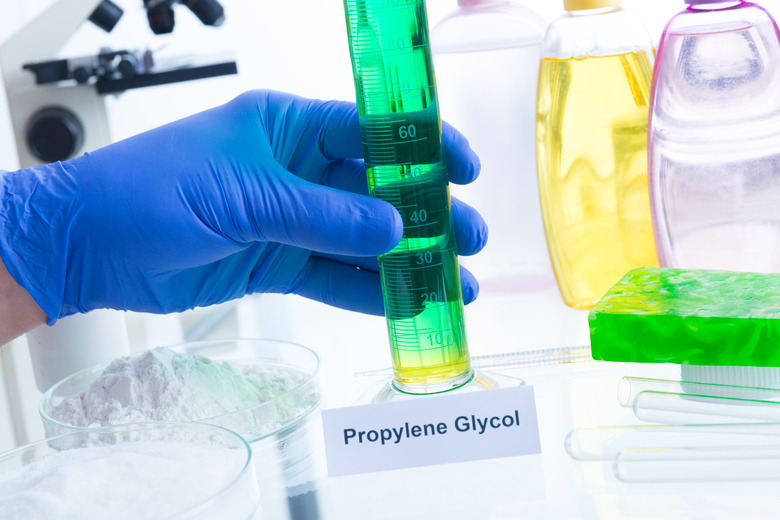How To Use Propylene Glycol
Propylene glycol is an organic compound with many industrial uses. It is a viscous liquid that is sweet, faint and transparent. The FDA (along with other international standards institutions) considers it to be generally safe to handle and to ingest and has certified the safety of using propylene glycol in medications, food flavors and for industrial purposes. However, although experts believe this liquid to be safe, there are those who may be allergic to it. It is therefore important to test for allergies before using substances that contain propylene glycol.
Step 1
Use propylene glycol as a solvent. Propylene glycol is an ideal solvent to mix chemicals while developing photographic films. Propylene glycol can also be used as a solvent in the manufacture of oral, topical applications and injections for the pharmaceutical industry, because it is insoluble in water. It is added to food colorings and flavorings because of its sweet flavor combined with its solvent properties. Propylene glycol is also used as a solvent to make paint, cleansers, inks, fingernail polish and removers and household cleaning agents. The semiconductor industry makes use of solvents called Cellosolves that contain propylene glycol.
Step 2
Utilize propylene glycol for its moisturizing properties. Adding propylene glycol to cosmetics and medicines will help them retain their moisture content. Food additives, toothpastes, mouthwashes, tobacco, lotions, hand sanitizers and saline lotions use propylene alcohol to retain moisture. It is used to regulate humidity in pipes and cigars to prevent dehydration. The moisturizing effect in deodorant sticks is achieved by adding propylene glycol. It is also a well-known humectant or moisturizer used as an additive to food for preservation.
Step 3
Use propylene glycol as a cooling compound. It is considered one of the best anti-freeze compounds for industrial use. It is added to automobile cooling systems to prevent radiator damage. A propylene glycol coating is used in fermenting tanks in the wine and beer industry. It is also used in cryonics to preserve living human bodies in hospitals.
Step 4
Add propylene glycol to food additives and liqueurs to give them a creamy texture. Using propylene glycol in additives like angostura and orange bitters will extend the taste and give more volume to the liquid.
Step 5
Add propylene glycol to fragrant oils. Propylene glycol is the most popular transdermal carrier in the cosmetic and pharmaceutical industry. Transdermal carriers transport oils through the pores of the skin. With the addition of transdermal carriers such as propylene glycol, topical applications like lotions and massage oils are transported through the skin to lubricate and rejuvenate skin cells.
Things Needed
- Stainless steel container
- Carbon steel container
- Safety goggles
- Gloves
TL;DR (Too Long; Didn't Read)
Propylene glycol should be stored in stainless steel containers or carbon steel containers that have an FDA-compliant coating. Use gloves and goggles while using the compound. A patch test should be done before use to ensure that the user is not allergic.
Warning
Propylene glycol can damage eyes and cause allergic reactions. If ingested by mistake, the person may experience stomach discomfort and nausea. It is important to be very careful while using the compound.
References
Cite This Article
MLA
Lee, Ezmeralda. "How To Use Propylene Glycol" sciencing.com, https://www.sciencing.com/use-propylene-glycol-5182747/. 16 July 2009.
APA
Lee, Ezmeralda. (2009, July 16). How To Use Propylene Glycol. sciencing.com. Retrieved from https://www.sciencing.com/use-propylene-glycol-5182747/
Chicago
Lee, Ezmeralda. How To Use Propylene Glycol last modified March 24, 2022. https://www.sciencing.com/use-propylene-glycol-5182747/
